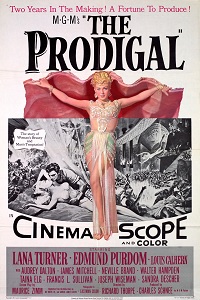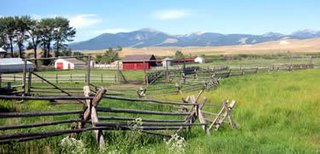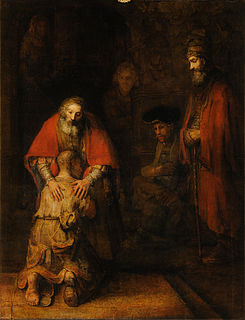
A swineherd is a person who raises and herds pigs as livestock.

The Parable of the Prodigal Son is one of the parables of Jesus Christ in the Bible, appearing in Luke 15:11–32. Jesus shares the parable with his disciples, the Pharisees and others.

According to the Bible, the golden calf was an idol made by the Israelites when Moses went up to Mount Sinai. In Hebrew, the incident is known as ḥēṭə’ hā‘ēgel or "the sin of the calf". It is first mentioned in the Book of Exodus.

Duxelles is a finely chopped (minced) mixture of mushrooms or mushroom stems, onions or shallots, herbs such as thyme or parsley, and black pepper, sautéed in butter and reduced to a paste. Cream is sometimes used as well, and some recipes add a dash of madeira or sherry. It is a basic preparation used in stuffings and sauces or as a garnish. Duxelles can also be filled into a pocket of raw pastry and baked as a savory tart.

The Prodigal is a 1955 Eastmancolor biblical epic CinemaScope film made by MGM starring Lana Turner and Edmund Purdom. It was based on the New Testament parable about a selfish son who leaves his family to pursue a life of pleasure. The film also features James Mitchell, Louis Calhern, Joseph Wiseman, Cecil Kellaway, Audrey Dalton, and Walter Hampden. Dancer Taina Elg made her film debut in The Prodigal.

Prithu is a sovereign (chakravarti), featured in the Puranas. According to Hinduism, he is an avatar (incarnation) of the preserver god—Vishnu. He is also called Prithu, Prithi and Prithvi Vainya, literally, "Prithu — the son of Vena". Prithu is "celebrated as the first consecrated king, from whom the earth received her (Sanskrit) name, Prithvi." He is mainly associated with the legend of his chasing the earth goddess, Prithvi, who fled in the form of a cow and eventually agreed to yield her milk as the world's grain and vegetation. The epic Mahabharata, Vishnu Purana, and the Bhagavata Purana describe him as a part-avatar (incarnation) of Vishnu.

A ranch is an area of land, including various structures, given primarily to ranching, the practice of raising grazing livestock such as cattle and sheep. It is a subtype of a farm. These terms are most often applied to livestock-raising operations in Mexico, the Western United States and Western Canada, though there are ranches in other areas. People who own or operate a ranch are called ranchers, cattlemen, or stockgrowers. Ranching is also a method used to raise less common livestock such as horses, elk, American bison, ostrich, emu, and alpaca.

The Return of the Prodigal Son is an oil painting by Rembrandt, part of the collection of the Hermitage Museum in St. Petersburg. It is among the Dutch master's final works, likely completed within two years of his death in 1669. Depicting the moment of the prodigal son's return to his father in the Biblical parable, it is a renowned work described by art historian Kenneth Clark as "a picture which those who have seen the original in St. Petersburg may be forgiven for claiming as the greatest picture ever painted".
Marcelle Praince was a French actress.

Heinz Warneke was an American sculptor best remembered as an animalier; his role in the direct carving movement "assured him a place in the annals of 20th-century American sculpture". In 1935 Heinz received the Widener Gold Medal for his sculpture Wild Boars.

The New Rochelle 250th Anniversary half dollar is a commemorative coin struck by the United States Bureau of the Mint to mark the 250th anniversary of the settling of New Rochelle in Westchester County, New York. Artist Gertrude K. Lathrop designed the piece; she was chosen after work by Lorrilard Wise was rejected by the federal Commission of Fine Arts (CFA). The coin depicts a fatted calf on one side, being led by John Pell, who sold the land on which New Rochelle now stands; the other shows a fleur de lis, an element of the city seal of New Rochelle and of France's La Rochelle, its eponym. The piece is dated 1938 but was minted the previous year. The New Rochelle piece was the last new-design commemorative struck by the Mint until 1946.

Slaughtered Ox, also known as Flayed Ox, Side of Beef, or Carcass of Beef, is a 1655 oil on beech panel still life painting by Rembrandt. It has been in the collection of the Louvre in Paris since 1857. A similar painting is in Kelvingrove Art Gallery and Museum, Glasgow, possibly by Rembrandt himself but probably by one of his pupils, perhaps Fabritius. Other similar paintings by Rembrandt or more likely his circle are held by museums in Budapest and Philadelphia.
Colette Brettel (1902–1973) was a British stage and film actress. Born Dorothy Nicolette Pettigrew in London, she made her screen debut in the 1920 film Wuthering Heights and appeared in several British films of the early 1920s including The Prodigal Son. Following the Slump of 1924, in which the number of British films released sharply declined, she moved to Germany. Her film career ended with the introduction of sound. She was married to the Dutch actor Ernst Winar.

The Vaynol is one of the United Kingdom's rarest breeds of cattle with less than 150 breeding animals registered. The breed is currently listed as “critical” on the Rare Breed Survival Trust list. There are currently three officially registered herds of Vaynol cattle existing in the United Kingdom. Together with the Chillingham and White Park cattle, the Vaynol is one of three horned breeds derived from ancient white parkland herds from Britain and Ireland. These park cattle were also the basis of a similar fourth breed, the polled British White.
Robert Ozanne was a French film actor.
Georges Bever (1884–1973) was a French film and television actor.
Robert Gys (1901–1977) was a French art director.

The Prodigal is a 1983 film directed by James F. Collier. It is a retelling of the story of the prodigal son and stars John Hammond, Hope Lange, John Cullum, Morgan Brittany, Ian Bannen, Joey Travolta, and Arliss Howard.
Maurice Marceau (1905-1979) was a French film actor. A character actor he appeared in a number of small or supporting roles during the 1930s, 1940s and early 1950s.

The Parable of the Prodigal Son is an oil painting by the brothers Frans Francken the Younger and Hieronymus Francken II, now in the collection of the Amsterdam Museum. It was created sometime between 1610 and 1620 in Antwerp and was acquired by the Amsterdam art collector Adriaan van der Hoop in 1843, who donated it to the city in 1854. It is on long term loan to the Rijksmuseum.














